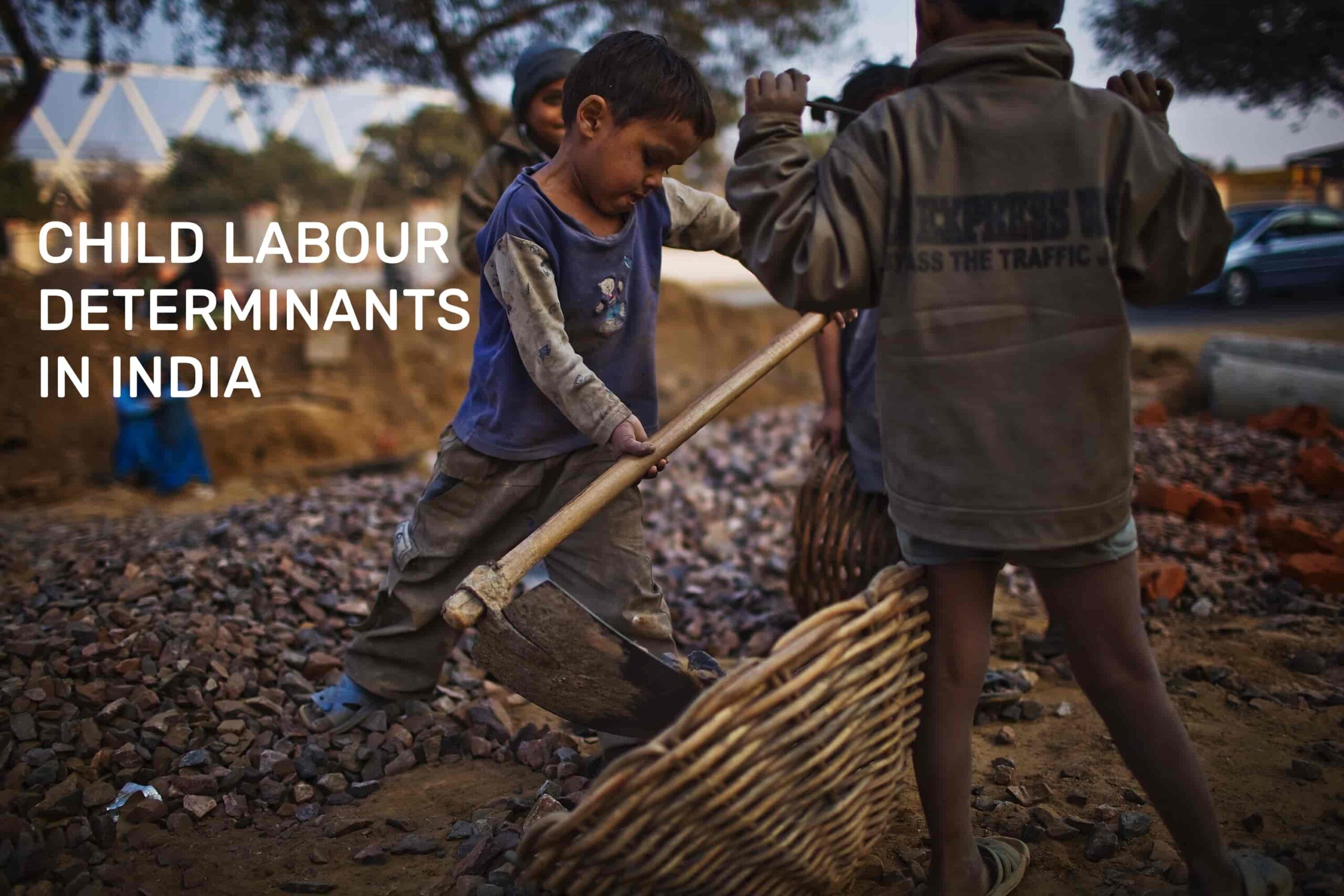Child Labour Determinants in India
April 12, 2023
According to ILO, Child labour is often defined as employment that deprives children of their childhood, potentials, and dignity, and that is detrimental to their physical and mental development.
The wellbeing of children is negatively correlated with their work. Children are vulnerable in a variety of ways and childhood is a time in life when additional attention is needed. Due to the frequent disruptions it causes to children’s capacity to attend and function well in school, child labour is a significant reason for concern. Because child labourers are more submissive, less demanding, and less likely to voice complaints about working conditions and treatment, child labourers are subject to both time and wage exploitation. Therefore, abuse and exploitation of working minors is a common occurrence.
Child Labour In India
- The Census of India 2011, reveals that 10.1 millions of 5–14 years children were working in India. However, as of 2020, 5.8 million children of 5–17 years are working in India (ILO & UNICEF, 2020; Kailash Satyarthi Children’s Foundation, 2020).
- Major proportions of child labourers are observed in the rural areas as agricultural labourers or household enterprises.
- Child labour is a result of landlessness, a large family size, belonging to a socially deprived community and indebted households. Poor households tend to send their children to work in order to supplement family income.
Determinants of Child Labour
- Education: The best strategy to keep kids out of the workforce is to send them to school. The reduction of child labour will undoubtedly be aided by better educational standards, more flexible curricula, easier entry into schools, financial assistance for further education, and a focus on vocational training.
- Additionally, children who attend educational institutions are less likely to be employed than illiterate children, therefore, they tend to avoid child labour (Khan & Lyon, 2015).
- Poverty: Several previous studies indicate that poverty is the main driving force of child labour in developing countries (Aggarwal, 2004; Kar, 2018; Mondal, Dalal, Sahoo, & Biswas, 2016; Sinha, 2019; ILO, 2020; ILO, 2021). Evidence shows that child labourers and their families in India experience a ’cycle of poverty’ characterized by hardship, a high rate of fertility, and illiteracy ( Lieten, 2000).
- Child labour is particularly pervasive among economically and socially vulnerable communities, such as agricultural labourers, casual labourers, and those belonging to Scheduled Caste (SC) and Scheduled Tribe (ST) communities due to their low asset base and lack of skills and education (Mehta & Mohanty, 2021).
- Also, a study conducted in Kolkata, India, discovered that child labour was more prevalent among uneducated parents (Banerjee et al., 2008; Mondal et al., 2016). Poverty could, thus, be an important impetus of child labour.
- Children as cheap labour, and with businesses and enterprises facing massive financial losses, the demand for cheap labour is going to increase.
- Migration and displacement: Children who are displaced from their homes or families due to conflict, natural disasters or other reasons are often vulnerable to exploitation and child labour.
- Due to reverse migration from urban centres, there is also going to be a shortage of adult labour. Children, especially adolescents, will be increasingly in demand to fill this gap
- Lack of enforcement of child labour laws: In India, child labour laws do exist, but they are not enforced, or they are insufficient to protect children from exploitation.
- Gender discrimination: Girls are often more vulnerable to child labour because of cultural beliefs that prioritize boys’ education over girls and because they are more likely to be engaged in domestic work, which is often not recognized as child labour.
Statistics on Child Labour in India (PLFS data 2020)
- India’s percentage of child labour ranges from 0 to 5.6 %.
- The national average for child labourers is 2.4 percent with states such as Madhya Pradesh, Gujarat, Jharkhand, Uttar Pradesh, Chhattisgarh, Andhra Pradesh, Odisha, and Tripura having a higher percentage than the national average.
- The farm or agriculture sector employs most of the child labour and it accounts for 51.8 % of child labour.
- In the non-farm sector, most of the children are employed in manufacturing (16.3%) industry, followed by wholesale and retail trade (13.9%), and construction (11.5%).
- More than 65 % of child labourers come from the poorest, poorer and middle-income households.
- Among child labourers, 9 % of children do not have any education and only 2 % of children have higher secondary and above levels of education. More than 82 % of children are Hindus and 14 % are Muslim. The highest, 45 % of children, belongs to the Other Backward Caste (OBC) community while the lowest 10 %, belongs to Scheduled Tribe (ST) community.
Insights on Child Labour in India
- The risk of child labour decreases if the children attend pre-primary and primary schools. But the increase in child labour with secondary education, and higher secondary and above level of education needs immediate attention because these are the children who are out of school to work and mostly in hazardous work.
- Although all other caste communities have a positive relationship with child labour when compared to Other (general caste) community, the coefficient distribution shows that ST households have the highest probability of sending their child to work, followed by the SC and OBC communities. The current observation reflects that in India, caste is a significant factor driving more children into the labour force.
- Male children are more likely to work than females (Ray, 2000; Sahoo, 2021).
- Children from the Muslim community were more likely to participate in child labour than children from the Hindu community.
- Child labourers are mostly from poor families, and almost all of them are from low caste or minority communities such as Scheduled Caste, Scheduled Tribe, Other Backward Caste, and Muslims. People belonging to these communities have few opportunities for a stable income, education, access to health care, basic rights, security of tenancy or land ownership, and access to the formal credit market (Kara, 2014).
- The household type has an effect on the child labour. The household types like self-employed in agriculture have a significant positive effect on child labour. This indicates that children who belong to the agricultural household have a higher probability of being in the workforce than the household with regular employment (Sahoo, 2021).
Child labour is a multifaceted issue that cannot be seen through the lens of poverty and education alone. The problem necessitates special attention on all fronts, and a one-size-fits-all policy prescription will not be sufficient. However, some variables are frequently difficult to estimate, and PLFS does not cover all variables; even if variables are present, the sample size is insufficient to estimate them. Furthermore, due to data limitations, some qualitative aspects such as social values and family orientation toward child labour are not possible (Sahoo, 2021). However, regulating and reducing child labour must be a priority in development discourse. It is difficult to eliminate child labour from the labour market without an appropriate development perspective. There is an urgent need for political mobilisation and determined campaign to end child labour.



